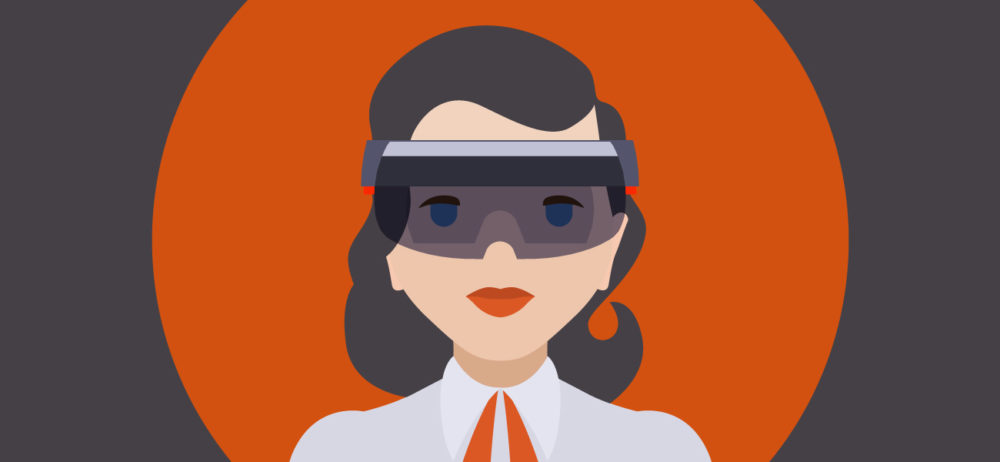Over a year ago, Intellectsoft had participated in two distinctive events — Dev_At_Work in New York and IT Forum in Kyiv. Augmented reality (AR) and virtual reality (VR) were in the spotlight at both gatherings. Putting these technologies into the current-day context, we now look back at their overlapping history — to gain a perspective on how they would change our future.
Last year, there was still a lot of doubt about augmented reality and virtual reality technology, even in the clean air of Silicon Valley streets. On Google Agency Day in NYC, Aaron Luber (a VP at Google responsible for the Daydream VR headset) said that one of the most frequently asked questions he gets is, “Did we miss the train on VR and AR?” His answer — no — is being backed up by a wide array of companies, mostly in retail. Other industries are understandably cautious. Both technologies were created as far back as the 1960’s and have only begun making noise recently. Still, companies start realising the benefits of augmented reality technology, as well as VR. BMW announced their AR retail app that allows users to showcase cars in real size anywhere, and Alibaba is infusing its shopping experiences with both VR and AR. More so, these technologies were put to use by the likes of IKEA and Converse in their retails apps at the beginning of the 2010’s, and are more familiar to everyone than they appear. The future of virtual reality technology, as well as AR, is hidden in the past.
The History of Augmented and Virtual Reality Technology
In 1962, Mortin Heilig decided to change the movie-going experience and created “Sensorama” — an early example of multisensory technology in a machine that showed 3D films in stereo and dispersed aromas at certain moments. This was the earliest prototype of virtual reality technology, and now it is bringing spectacle to our daily activities as much as it is changing the entertainment business.
See the video:
He was not the only one contributing to this technologic shift at that time. In 1968, eminent computer scientist Ivan Sutherland built “The Sword of Damocles,” an experimental head mounted display that was the precursor of both augmented reality technology and VR. In the small clip that sees the scientist showcasing his invention, the display looks surreal and unwieldy, but without it Amazon Go, AR-based mcommerce services, and other existing business use cases for augmented reality technology would not have existed.
A Different Kind of Past of VR and AR
Businesses are always cautious when it comes to major change, so it is no wonder they were worried about these technologies and bid their time until VR and AR started becoming business and mcommerce trends. Virtual reality is a groundbreaking technology that will transform many industries. Still, for a long time it existed only in popular culture fiction, not the real world. Augmented reality technology is different. Upon closer examination, it turns out that its core promise is not only familiar, but used by business everywhere. The promise of the technology used in augmented reality was there for decades.
Let’s explore the matter.
Ultimately, reality is an experience, and this experience is relative. In some cases, it can be changed by adding — or “augmenting” — different physical elements and layers to the existing physical reality, changing it to a certain extent. When it comes to business, this means creating a user experience that, like augmented reality technology, slightly changes the reality by “augmentation” of certain elements — like aromas and lighting.
The retail industry has been using this “augmentation” for years. In the US, Abercrombie & Fitch “augmented” their in-store experience with loud music, recognizable aroma, and low lighting to create a user experience that resembles a teenager’s room.
Another bright example is the jewelry industry. Most of the jewelry houses have glaring lighting. The idea is as simple as it is ingenious: the natural gleam of diamonds is amplified with the help of brighter lighting to create and sustain a sense of wealth and prosperity. One of the industry’s top publications even noted that jewelry stores shouldn’t regard lighting as an expense, as it increases sales and profitability.
Of course, no smartphones and retails apps are involved in these examples, and, from a certain perspective, these were the first business use cases for augmented reality technology.
Future of Augmented Reality and Virtual Reality Technology
In the 2000’s, businesses gave a cold welcome to ecommerce; and although a smartphone had become an economic necessity in 2017, companies were only starting to embrace mobile in full that year. Hence, entire industries should consider embracing and exploring VR and AR faster, as they present clear possibilities to deliver both value and spectacle to their customers.
The impact of augmented reality and virtual reality technology on business and our lives will be immense. The reasoning behind the statement is rather simple: in the age of internet and advanced technology, the user experience has been moving from the physical world to the virtual world. It started with smartphones, and it will continue with AR and VR. Consequently, this provides businesses with opportunities to grow, innovate, and increase profits — the same opportunity that mobile has given to every company. Inspiration is out there in the promising endeavors — like Microsoft’s hands-free augmented reality headset HoloLens. Virtual reality technology trends and solutions are also coming in numbers — physical, not just virtual.
Learn more about latest augmented reality technology in general, and AR in construction.

